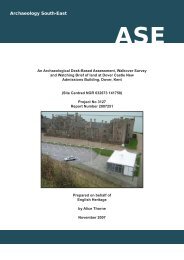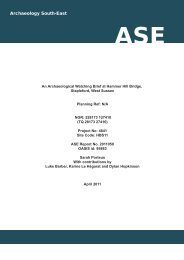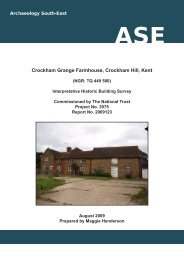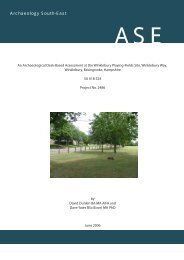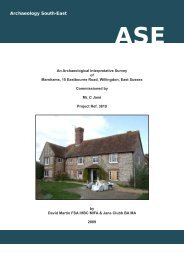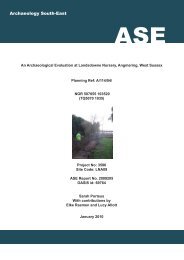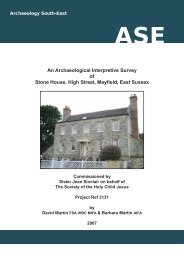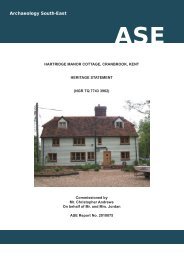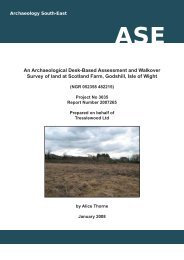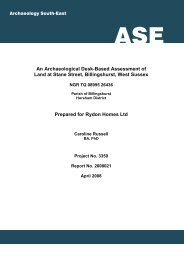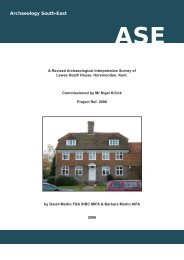ASE front cover - Archaeology South-East
ASE front cover - Archaeology South-East
ASE front cover - Archaeology South-East
Create successful ePaper yourself
Turn your PDF publications into a flip-book with our unique Google optimized e-Paper software.
<strong>Archaeology</strong> <strong>South</strong>-<strong>East</strong>2008058: Holbury Infants School, Holbury, HampshireWare Types % of group by sherd count % of group by weightAmphora 1.1 4.7Coarse-wares 83.6 83.5Imported fine-wares 3.6 3.4RB fine-wares 8.9 4.9White-wares 2.8 3.5Table 5: Ware Types from pit [1057]5.1.5 Chronology5.1.5.1 The pottery comprises a fairly homogenous group dated to between AD 270and 325/350 and there is no clear evidence for distinct sub-phases withinthis date-range. A high proportion of the assemblage can be securely datedto after AD 270 and there was probably no activity of any intensity beforethis date. Although a small but significant quantity of residual 2 nd centurymaterial is present on the site, the majority of this is samian which may haveremained in use for a substantial period of time after production ceased.Alternatively, the earlier material may derive from activity associated withthe earlier Roman Road in the vicinity of the site, the 2 nd and 3 rd centurymaterial relating to the construction and initial use of the road prior to moredeveloped settlement and activity on the site.5.1.5.2 Detailed analysis of groups from Portchester suggest that there is relativelylittle change in the proportion of fabrics during the late 3 rd and 4 th centuries,the most notable trait being the first appearance of Portchester D warearound AD 325 and a marked increase in Oxfordshire colour-coated wareafter around AD 350 (Fulford 1975a, 275, 282-286, 299). As only one sherdof the former and three of the latter are present it seems likely that activityon the site had mostly ceased by the mid 4 th century.5.1.6 Status/Function5.1.6.1 The assemblage is characteristic of domestic activity and the vast majorityof forms, which are derived from black-burnished prototypes, are related topreparation, cooking and serving of food, a point supported by the highlevels of sooting. It is notable that the assemblage has a very highproportion of fine wares, making up about 10%, which is perhaps moretypical of high status villa assemblages. However, fine-wares were probablyreadily available close to production sites even on lower status settlementsites.5.2 The Ceramic Building MaterialsSusan Pringle5.2.1 Introduction5.2.1.1 The building materials assemblage consists of 238 fragments of Roman andpost-Roman tile and brick weighing 38.7 kilograms. Almost all the materialis of Roman date with post-medieval tile occurring only in the topsoil and theuppermost fill of probable quarry pit [1009].5.2.2 Summary24© <strong>Archaeology</strong> <strong>South</strong>-<strong>East</strong>



